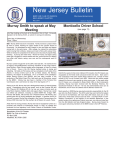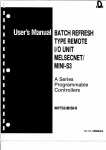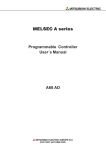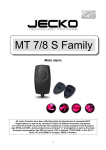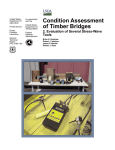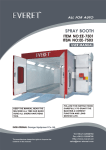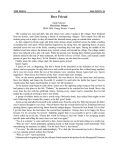Download NJBMWCCA_Tech_FAQ
Transcript
New Jersey Chapter - BMWCCA Frequently Asked Questions Concerning Pre-Event Car Inspection And Helmets What is a pre-event inspection and why does my car need it? A driver school can stress your vehicle more than everyday street driving. So a thorough pre-event inspection by a qualified individual(s) is required to establish that the vehicle is in fact suitable, and safe, for track use. Any items found to be needing attention during the pre-event inspection should of course be addressed at that time. Therefore, not only is it a pre-event inspection, it is pre-event car preparation as well. The New Jersey Chapter “Tech” Form is intended to serve as a guide for the pre-event inspection which is to occur before the car is brought to the event. In completing the form, the participant is documenting the inspection that she/he and/or a designee performs. Furthermore, the participant is certifying that the vehicle has been inspected, any necessary repairs performed, and that he/she is responsible for the safe condition of the vehicle. Please note that the pre-event inspection should entail putting the car up on jackstands or a lift and removing all 4 wheels for access to the brakes and rotors and for a thorough underbody examination. Please note that the NJ Chapter cannot and will not perform your pre-event inspection. The inspection must have been completed before you arrive at the track. If you have any questions regarding the pre-event inspection, contact the Chief of Tech at [email protected]. What does a “properly completed” NJ Chapter Tech Form look like? Please refer to the attached sample Tech form. Note that the “Xs” for Items 1 – 23 have been typed in for the example. They should be filled in by hand on your actual Tech form. What do I do with the Tech form? After completing the Tech form at the time of the pre-event inspection, bring the form with you to the event and present it when asked to as part of the NJ Chapter “Tech” and registration process at the event. Please see “What does the NJ Chapter ‘Tech’ at the event entail?”, below. My car is almost new, why does it need a pre-event inspection? Even if your car is only several months old, it still must undergo your pre-event inspection. Although it is not likely that a new vehicle will have worn components, it is possible that the vehicle has sustained damage from road debris, potholes, etc. Moreover, wear items such as brakes, tires, drive belts, etc, should receive a close inspection even on a practically new vehicle. And even on a new car, the brake fluid will likely be more than 6 months old and will need to be flushed/replaced. Please see “Why does my brake fluid need to be less than 6 months old?”, below. And of course the wheel-nut or wheel-bolt torque should be checked, both prior to the event and periodically during the event. This requires a torque wrench and a socket of the appropriate size for your wheel lug bolts/nuts. For the current tighteningtorque specification for your particular car, query your dealer, your owner’s manual or a service manual. One of my tires has a “bubble” on the sidewall, is this tire acceptable for use at a NJ Chapter Driver School? No. Your pre-event inspection should include [See Tech form Item #20.] a careful examination of your tires, including the sidewalls and treads. Version Mar 12 Copyright 2012 - New Jersey Chapter, BMWCCA, Inc. Page 1 of 6 Can I do my own pre-event inspection or must I take my car to a shop? Our requirement is that the car be inspected by a qualified individual who is familiar with the make and model of the car being inspected. If you feel you are qualified to inspect the car and certify it safe for driver-school use, that is fine with us. If you have a friend who you feel is qualified, and you and he/she inspect the car together, or he/she inspects the car for you, that is fine with us as well. If you choose to hire a shop or other qualified individual to inspect the car, that also will be fine with us. The important thing to remember is that, regardless of who performs the pre-event inspection, it is the event participant(s) who, by signing the Tech form, are certifying that the car has been inspected and properly prepared for the driver school, and who are assuming the responsibility for the safe condition of the vehicle. So even if you choose to hire a shop or qualified automobile technician to perform your pre-event inspection and vehicle preparation, and even if the shop or technician “checks the boxes” in the Tech form as part of the service, it is the event participant(s) who must sign the Tech form in the “Safety Inspection Waiver” section on Page 2 of the form. I have aftermarket glass tinting on my rear windshield. The other track organizations and BMWCCA chapters I participate with do not object to the tinting, and it passes my state’s motor-vehicle inspection. Will my tinting be allowed at a New Jersey Chapter driver school? Tinting restrictions, if any, vary from chapter to chapter, as do other car-preparation requirements. Hence, one chapter’s acceptance of tinting does not usually apply to other chapters, unless there are specific reciprocity agreements in place. The NJ Chapter does not have any such agreements with other chapters. Similarly, acceptance of your tinting by your state’s motorvehicle authority does not ensure acceptance by the NJ Chapter. The purpose of our tinting restriction is to ensure that following drivers have an unobstructed view into and through your car. Our restrictions apply only to the front and rear windshields. Side windows are not an issue. Some time ago we tried to quantify the amount of tinting allowed, but the effort was made overly complicated by several variables, two being the type of tinting and the angle of the rear windshield. So we reverted to the old calibrated eyeball. It's virtually impossible for us to approve unconditionally your tinting without our seeing it. For an initial evaluation of your tinting, you can email a photo file to [email protected]. Shoot outdoors in daylight with no flash from about 15 ft. from the rear while looking through the rear window into the interior. Stand directly behind the car and hold the camera about 4 feet from the ground. If the tinting is too dark, sometimes we can tell from the photo, and save everyone some hassle. What we try to do from a good photo is say that the tinting will be accepted at least for what we call a “One-Time Exemption” so we get to see it at the event with little risk of having to reject it. The last thing we want to do is send someone home, or require her/him to remove the tinting at the event [not a fun job]. If the photo-file option is not viable, then there are not many palatable options available for the tints we do not approve prior to the event. If you take the risk of coming to the event without pre-approved tinting, there are three possible outcomes re the tinting: 1. We deem it OK. 2. We deem it marginal and you get a ‘One-Time Exemption’ for that one event. 3. We cannot accept it and you will be required to remove it in order to drive the car on the track. Why does my brake fluid need to be less than 6 months old? DOT 3 or DOT 4 brake fluid, the type normally found in automobiles, is hygroscopic, meaning that it will absorb water. Over time, the brake fluid becomes contaminated with atmospheric moisture, and the fluid’s boiling point is reduced significantly. This can lead to fluid boiling, and partial or complete loss of your brakes, under hard-braking conditions such as can be experienced at a driver school. The only way to remove this contamination is by replacing the brake fluid with new fluid from a sealed container and flushing the old fluid from the system. Plan on using about a quart or liter of brake fluid for this procedure. Please note that flushing/changing the brake fluid is a more involved procedure than simply “bleeding the brakes”, so if you are having someone change your brake fluid, you need to ensure that he or she is aware of the distinction. Version Mar 12 Copyright 2012 – New Jersey Chapter, BMWCCA, Inc. Page 2 of 6 What does the NJ Chapter "Tech" entail at the event? The first person you will encounter in our “Tech” line is our Helmet Checker/Tech screener. This person will examine your helmet to see if it is Snell 2005 or later approved (See question on helmets, below). This person will also take a quick look at your Tech form, which you should have completed when your pre-event inspection was performed. Small omissions on your Tech form will be pointed out to you and you will be asked to complete the missing information. If for some arcane reason you do not have a Tech form or your form is not nearly complete, you will be asked to pull out of the Tech line until you can present a properly-completed Tech form. Note that the Tech Crew does not maintain a supply of blank Tech forms. It is a huge help to us if you arrive at the event with your Tech form already properly completed. The Helmet Checker will then direct you to pull ahead to the next stage of “Tech”, the Pre-Checkers. The Pre-Checkers verify that your Tech form is properly completed. They also check your stop lamps, compare the VIN (Vehicle Identification Number, AKA Serial Number) to what you indicated on your tech form, examine any glass tinting, and ensure you have equivalent front-seats and seat belts and that you have a passenger-door mirror. The passenger-seat and doormirror requirement is only for student cars. The Pre-Checkers also will caution you that your car’s interior must be emptied of all loose items, including radar detectors and E-Z Pass transponders, prior to your driving on the track. (Any loose items in the luggage compartment should of course also be removed, along with your driver-side floor mat.) The Pre-Checkers will then direct you to pull forward to the final stage of “Tech”. Here our personnel will take a quick look under the hood of your car for filler caps out of place or loose, cracked drive belts, broken fan blades, fluid leakage, etc. Tech personnel also will quickly examine your track tires, check that your gas cap is in place and tight, look for major leaks, turn your steering wheel to check for obvious lost motion or clunks, and step on your brake pedal. On some cars, the battery is checked to see if it appears to be securely installed. Please note that not all cars undergo this final stage of “Tech”. It is performed at our discretion. Clearly, the above-described “Tech”, in which your car is looked at for only several minutes, cannot possibly serve in lieu of the much more detailed pre-event inspection that you have documented on the Tech form. The purpose of our event “Tech” is to attempt to catch obvious problems that somehow went undetected during the pre-event inspection and/or emerged on your trip to the track. Note that your car is not lifted off the ground for event “Tech”. Note that it is neither the policy nor the function of the NJ Chapter Tech Crew to perform any repairs or disassembly/reassembly whatsoever in the event “Tech” line. Furthermore, it is not our practice to apply tools of any kind to participant cars. This applies particularly to our applying a torque wrench to your wheel bolts/nuts: We do not do this. At this point your Tech form will receive final approval and you will be directed to leave your car in the paddock and to submit your approved Tech form to event registration. At registration, after signing the liability waiver you will be issued your car numbers, an event schedule, and a wrist band. After this you should return to your paddock spot, apply your car numbers to the rear-quarter windows, ensure your car interior is empty and your car glass is clean, do a final check on your tire pressures and wheel lug bolt/nut torques, and prepare to attend the drivers’ meeting when it is announced on the PA system. Does the NJ Chapter “Tech” instructor cars? Yes, instructor cars are subject to the same pre-event inspection requirements and event “Tech” requirements as student cars. The only difference is that instructor cars are not required to have equivalent passenger seats and harnesses and a passenger-door mirror. I plan on participating in another organization's driving event the week before the NJ Chapter's. Should I perform another pre-event inspection before coming to the NJ Chapter event? Yes Version Mar 12 Copyright 2012 – New Jersey Chapter, BMWCCA, Inc. Page 3 of 6 The registration materials and Tech form I received refer to “Snell-Approved” helmets. What does this mean? The Snell Memorial Foundation is an organization that performs testing on automobile and motorcycle helmets. All the major helmet manufacturers submit helmets for Snell testing. When a helmet meets the requirements of Snell’s testing, the manufacturer is allowed to represent the helmet as such by affixing what we call the “Snell Label” to the liner of the helmet. The photo shows what the Snell label looks like. The NJ Chapter will only accept helmets with Snell 2005 or later ratings. Any helmet not Snell approved (no Snell label inside the helmet) or with a Snell rating older than 2005 is not acceptable for use at a NJ Chapter driver school. See the question on other acceptable helmet approvals below. I see that the Snell helmet ratings are either “M” or “SA”, do you accept both and what does this mean? The “M” rating stands for “Motorcycle”, and the “SA” for “Special Application”. Either is acceptable for use at a NJ Chapter driver school. Does the NJ Chapter accept helmets with approvals other than Snell? Yes. Full-face helmets with SFI 31.1 or FIA 8860 approval are also accepted. Note that the helmet-approval designation must be specific. For example, “SFI approved” is not specific, while “SFI 31.1 Approved” is. Are open-faced helmets accepted by the NJ Chapter? For events at New Jersey Motorsports Park, full-face helmets are required. It is recommended that you bring the face shield for your helmet. Where can I purchase a helmet suitable for use at a NJ Chapter driver school? A quick Internet search will reveal that there are many sources of Snell-approved helmets. We strongly recommend that, as part of your helmet-selection process, you try on helmets and with the help of a sales professional determine your correct helmet size. An improperly fitted helmet can be at best uncomfortable, and at worst, unsafe. Also, note that just because a size “X” helmet from Manufacturer A fits you, do not assume that a similarly-sized helmet from Manufacturer B will fit the same. Indeed, some size variations may exist among different helmet models from the same manufacturer. Will I be able to borrow a helmet from the NJ Chapter for the driver school? For our newcomers, the NJ Chapter has a few helmets that are available to borrow. Please e-mail [email protected] early if you would like to arrange to borrow a helmet. Helmets are available first-come, first-served, so sign-up early! We require that you use a head-sock [balaclava] with our helmets. Head-socks are available for less than $10 at most online race-supply shops. Also, the NJ Chapter has disposable head-socks available for purchase for a nominal amount. Version Mar 12 Copyright 2012 – New Jersey Chapter, BMWCCA, Inc. Page 4 of 6 Item #24 on the Tech Form refers to torquing the E30 M3 alternator-belt-adjusting-bar bolts. Where are these bolts and how tight should I make them? Refer to the following 2 photographs. Tighten the bolt in the left-hand photo and the nut in the right-hand photo [see arrows] to 16-18 lb.-ft. Note that this only applies to the E30 [’88-‘91] 4-cylinder M3. I have heard something about problems with radiators on some BMW models. Can you elaborate? The following BMW models have experienced catastrophic failures of the upper radiator neck [see photo]: E34 [5-Series ’89-‘95]; E36 [3-Series ’92-‘99]; E38 [7-Series ’95-‘01]; E39 [5-series ’96-‘05] The upper radiator neck shears off without warning. A large amount of coolant is quickly disgorged, resulting in slippery coolant being spread over the track surface and almost immediate overheating of the engine. In some instances, the “plastic” engine-coolant outlet has failed in the same manner. It is unlikely that the imminence of either of these failures can be predicted by your pre-event inspection. Therefore, if your original or replacement radiator or “plastic” engine-coolant outlet is more than a few years old, it is strongly recommended that it be replaced as a preventive measure. The “plastic” belt-driven radiator fan should be replaced at this time as well. Version Mar 12 Copyright 2012 – New Jersey Chapter, BMWCCA, Inc. Page 5 of 6 What’s up with the power-steering-hose failures on E36 [92-99 3-Series] models? During the past couple seasons, we have been seeing on-track failures of power-steering hoses on E36 models, including M3s. The return hose pulls off the fluid-cooler outlet and steering fluid is disgorged onto the track surface, posing hazard for both the afflicted vehicle and for following vehicles. There is a document on the chapter website that addresses this problem and suggests one possible solution. If you are bringing an E36 to the track, be sure to review this document and seriously consider replacing the return hose as described in the document. At event-day “Tech” we will be asking if the return hose has been replaced. There is an item on the Tech Form pertaining to the steering-column lock. I am not sure how to check mine. The steering-column lock [steering-wheel lock] is of course an anti-theft feature, and we are clearly not concerned with this at a driver school. What we are concerned with is that, as the locking mechanism ages and wears, it may not function properly. The original intent of the column lock was that it lock when the key is removed, NOT when the key is turned to the “OFF” position. We have seen, particularly on older cars, that the column locks when the key is turned off yet kept inserted. Our concern is that, in the event of a stuck-open throttle on the track, the driver’s first reaction may be to turn off the ignition. Of course, if a malfunctioning column lock were to lock during this situation, steering control of the vehicle would be lost, with possibly disastrous results. It is easy to check your column lock. With the vehicle stationary and the engine running, turn off the ignition but leave the key inserted. The column SHOULD NOT lock if the steering wheel is turned. If it does lock, you will have to have the mechanism replaced or the lock defeated. This is not likely to be easily accomplished at the track, so be sure to address this as part of your pre-event preparation. Note that we will be checking this at event-day “Tech” and vehicles with malfunctioning column locks will not be allowed on the track. Version Mar 12 Copyright 2012 – New Jersey Chapter, BMWCCA, Inc. Page 6 of 6








